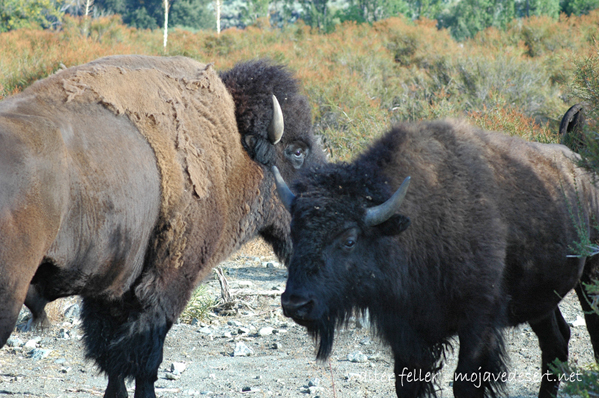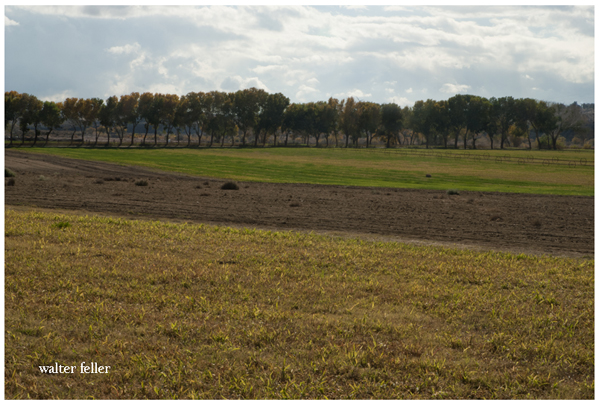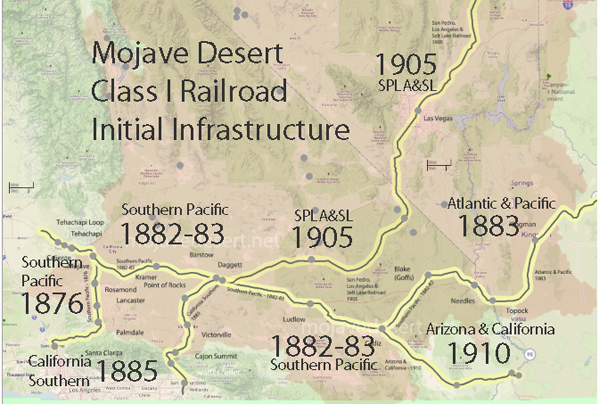Top Down Mojave History
There are so many events and circumstances that began outside the Mojave Desert helping to shape the Mojave; its various histories, topographies and values, that one way to examine and learn of this region is to study these influences. - Editor.Late 19th Century Overview
In the decades following the Civil War, the United States emerged as an industrial giant. Old industries expanded and many new ones, including petroleum refining, steel manufacturing, and electrical power, emerged. Railroads expanded significantly, bringing even remote parts of the country into a national market economy.Industrial growth transformed American society. It produced a new class of wealthy industrialists and a prosperous middle class. It also produced a vastly expanded blue collar working class. The labor force that made industrialization possible was made up of millions of newly arrived immigrants and even larger numbers of migrants from rural areas. American society became more diverse than ever before.
Not everyone shared in the economic prosperity of this period. Many workers were typically unemployed at least part of the year, and their wages were relatively low when they did work. This situation led many workers to support and join labor unions. Meanwhile, farmers also faced hard times as technology and increasing production led to more competition and falling prices for farm products. Hard times on farms led many young people to move to the city in search of better job opportunities.
Americans who were born in the 1840s and 1850s would experience enormous changes in their lifetimes. Some of these changes resulted from a sweeping technological revolution. Their major source of light, for example, would change from candles, to kerosene lamps, and then to electric light bulbs. They would see their transportation evolve from walking and horse power to steam-powered locomotives, to electric trolley cars, to gasoline-powered automobiles. Born into a society in which the vast majority of people were involved in agriculture, they experienced an industrial revolution that radically changed the ways millions of people worked and where they lived. They would experience the migration of millions of people from rural America to the nation's rapidly growing cities.
The American West, 1865-1900

The completion of the railroads to the West following the Civil War opened up vast areas of the region to settlement and economic development. White settlers from the East poured across the Mississippi to mine, farm, and ranch. African-American settlers also came West from the Deep South, convinced by promoters of all-black Western towns that prosperity could be found there. Chinese railroad workers further added to the diversity of the region's population.
Settlement from the East transformed the Great Plains. The huge herds of American bison that roamed the plains were almost wiped out, and farmers plowed the natural grasses to plant wheat and other crops. The cattle industry rose in importance as the railroad provided a practical means for getting the cattle to market.
The loss of the bison and growth of white settlement drastically affected the lives of the Native Americans living in the West. In the conflicts that resulted, the American Indians, despite occasional victories, seemed doomed to defeat by the greater numbers of settlers and the military force of the U.S. government. By the 1880s, most American Indians had been confined to reservations, often in areas of the West that appeared least desirable to white settlers.
The cowboy became the symbol for the West of the late 19th century, often depicted in popular culture as a glamorous or heroic figure. The stereotype of the heroic white cowboy is far from true, however. The first cowboys were Spanish vaqueros, who had introduced cattle to Mexico centuries earlier. Black cowboys also rode the range. Furthermore, the life of the cowboy was far from glamorous, involving long, hard hours of labor, poor living conditions, and economic hardship.
The myth of the cowboy is only one of many myths that have shaped our views of the West in the late 19th century. Recently, some historians have turned away from the traditional view of the West as a frontier, a "meeting point between civilization and savagery" in the words of historian Frederick Jackson Turner. They have begun writing about the West as a crossroads of cultures, where various groups struggled for property, profit, and cultural dominance.
Immigration to the United States, 1851-1900
In the late 1800s, people in many parts of the world decided to leave their homes and immigrate to the United States. Fleeing crop failure, land and job shortages, rising taxes, and famine, many came to the U. S. because it was perceived as the land of economic opportunity. Others came seeking personal freedom or relief from political and religious persecution, and nearly 12 million immigrants arrived in the United States between 1870 and 1900. During the 1870s and 1880s, the vast majority of these people were from Germany, Ireland, and England - the principal sources of immigration before the Civil War. Even so, a relatively large group of Chinese immigrated to the United States between the start of the California gold rush in 1849 and 1882, when federal law stopped their immigration.With the onset of hard economic times in the 1870s, European immigrants and Americans began to compete for the jobs traditionally reserved for the Chinese. With economic competition came dislike and even racial suspicion and hatred. Such feelings were accompanied by anti-Chinese riots and pressure, especially in California, for the exclusion of Chinese immigrants from the United States. The result of this pressure was the Chinese Exclusion Act, passed by Congress in 1882. This Act virtually ended Chinese immigration for nearly a century.
Immigrants entered the United States through several ports. Those from Europe generally came through East Coast facilities, while those from Asia generally entered through West Coast centers. More than 70 percent of all immigrants, however, entered through New York City, which came to be known as the "Golden Door." Throughout the late 1800s, most immigrants arriving in New York entered at the Castle Garden depot near the tip of Manhattan. In 1892, the federal government opened a new immigration processing center on Ellis Island in New York harbor.
Although immigrants often settled near ports of entry, a large number did find their way inland. Many states, especially those with sparse populations, actively sought to attract immigrants by offering jobs or land for farming. Many immigrants wanted to move to communities established by previous settlers from their homelands.
Once settled, immigrants looked for work. There were never enough jobs, and employers often took advantage of the immigrants. Men were generally paid less than other workers, and women less than men. Social tensions were also part of the immigrant experience. Often stereotyped and discriminated against, many immigrants suffered verbal and physical abuse because they were "different." While large-scale immigration created many social tensions, it also produced a new vitality in the cities and states in which the immigrants settled. The newcomers helped transform American society and culture, demonstrating that diversity, as well as unity, is a source of national strength.
City Life in the Late 19th Century
Between 1880 and 1900, cities in the United States grew at a dramatic rate. Owing most of their population growth to the expansion of industry, U.S. cities grew by about 15 million people in the two decades before 1900. Many of those who helped account for the population growth of cities were immigrants arriving from around the world. A steady stream of people from rural America also migrated to the cities during this period. Between 1880 and 1890, almost 40 percent of the townships in the United States lost population because of migration.Industrial expansion and population growth radically changed the face of the nation's cities. Noise, traffic jams, slums, air pollution, and sanitation and health problems became commonplace. Mass transit, in the form of trolleys, cable cars, and subways, was built, and skyscrapers began to dominate city skylines. New communities, known as suburbs, began to be built just beyond the city. Commuters, those who lived in the suburbs and traveled in and out of the city for work, began to increase in number.
Many of those who resided in the city lived in rental apartments or tenement housing. Neighborhoods, especially for immigrant populations, were often the center of community life. In the enclave neighborhoods, many immigrant groups attempted to hold onto and practice precious customs and traditions. Even today, many neighborhoods or sections of some of the great cities in the United States reflect those ethnic heritages.
During the final years of the 1800s, industrial cities, with all the problems brought on by rapid population growth and lack of infrastructure to support the growth, occupied a special place in U.S. history. For all the problems, and there were many, the cities promoted a special bond between people and laid the foundation for the multiethnic, multicultural society that we cherish today.
Rural Life in the Late 19th Century

The United States began as a largely rural nation, with most people living on farms or in small towns and villages. While the rural population continued to grow in the late 1800s, the urban population was growing much more rapidly. Still, a majority of Americans lived in rural areas in 1900.
Many of those Americans had settled on the plains in the 1880s. Abundant rainfall in the 1880s and the promise of free land under the Homestead Act drew easterners to the plain. When dry weather returned, the homesteaders' crops failed, sending many of them into debt, farther west, or back to the east or south. Farmers began to organize into groups called Granges and Farmers' Alliances to address the problems faced by farmers. Some farmers tried to launch a new political party, the People's Party (or Populists), running a candidate for president in 1892. Unfortunately, their candidate did not do well, drawing only about 8 percent of the vote.
New machines for use in farming were invented in this period, but horses, oxen, and people still provided most of the power that operated the machinery. While farmers now produced cash crops (crops grown for sale), they were still remarkably self-sufficient, often making or trading for nearly everything required by their own families.
Work in the Late 19th Century
The late 19th-century United States is probably best known for the vast expansion of its industrial plant and output. At the heart of these huge increases was the mass production of goods by machines. This process was first introduced and perfected by British textile manufacturers.In the century since such mechanization had begun, machines had replaced highly skilled craftspeople in one industry after another. By the 1870s, machines were knitting stockings and stitching shirts and dresses, cutting and stitching leather for shoes, and producing nails by the millions. By reducing labor costs, such machines not only reduced manufacturing costs but lowered prices manufacturers charged consumers. In short, machine production created a growing abundance of products at cheaper prices.
Mechanization also had less desirable effects. For one, machines changed the way people worked. Skilled craftspeople of earlier days had the satisfaction of seeing a product through from beginning to end. When they saw a knife, or barrel, or shirt or dress, they had a sense of accomplishment. Machines, on the other hand, tended to subdivide production down into many small repetitive tasks with workers often doing only a single task. The pace of work usually became faster and faster; work was often performed in factories built to house the machines. Finally, factory managers began to enforce an industrial discipline, forcing workers to work set hours which were often very long.
One result of mechanization and factory production was the growing attractiveness of labor organization. To be sure, craft guilds had been around a long time. Now, however, there were increasing reasons for workers to join labor unions. Such labor unions were not notably successful in organizing large numbers of workers in the late 19th century. Still, unions were able to organize a variety of strikes and other work stoppages that served to publicize their grievances about working conditions and wages. Even so, labor unions did not gain even close to equal footing with businesses and industries until the economic chaos of the 1930s.
Railroads in the Late 19th Century

Beginning in the early 1870s, railroad construction in the United States increased dramatically. Prior to 1871, approximately 45,000 miles of track had been laid. Between 1871 and 1900, another 170,000 miles were added to the nation's growing railroad system. Much of the growth can be attributed to the building of the transcontinental railroads. In 1862, Congress passed the Pacific Railway Act, which authorized the construction of a transcontinental railroad. The first such railroad was completed on May 10, 1869. By 1900, four additional transcontinental railroads connected the eastern states with the Pacific Coast.
Four of the five transcontinental railroads were built with assistance from the federal government through land grants. Receiving millions of acres of public lands from Congress, the railroads were assured land on which to lay the tracks and land to sell, the proceeds of which helped companies finance the construction of their railroads. Not all railroads were built with government assistance, however. Smaller railroads had to purchase land on which to lay their tracks from private owners, some of whom objected to the railroads and refused to grant rights of way.
Laying track and living in and among the railroad construction camps was often very difficult. Railroad construction crews were not only subjected to extreme weather conditions, they had to lay tracks across and through many natural geographical features, including rivers, canyons, mountains, and desert. Like other large economic opportunity situations in the expanding nation, the railroad construction camps attracted all types of characters, almost all of whom were looking for ways to turn a quick profit, legally or illegally. Life in the camps was often very crude and rough.
By 1900, much of the nation's railroad system was in place. The railroad opened the way for the settlement of the West, provided new economic opportunities, stimulated the development of town and communities, and generally tied the country together. When the railroads were shut down during the great railroad strike of 1894, the true importance of the railroads was fully realized.
Adapted from ~ U.S. History Primary Source Timeline - Library of Congress